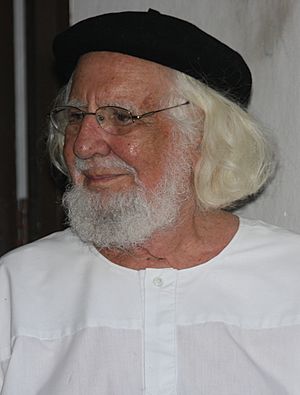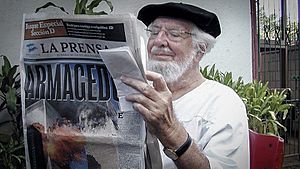Ernesto Cardenal facts for kids
Quick facts for kids
Ernesto Cardenal
|
|
|---|---|

Cardenal in 2008
|
|
| Born |
Ernesto Cardenal Martínez
20 January 1925 |
| Died | 1 March 2020 (aged 95) |
| Nationality | Nicaraguan |
| Occupation | |
| Years active | 1954–2020 |
| Known for | Nicaraguan cultural figure |
|
Notable work
|
The Gospel in Solentiname |
Ernesto Cardenal Martínez (born January 20, 1925 – died March 1, 2020) was a famous Nicaraguan Catholic priest, poet, and politician. He was a key figure in Liberation theology, which is a way of understanding faith that focuses on helping the poor and fighting for justice.
Cardenal started an art community on the Solentiname Islands, where he lived for over ten years. He was also a member of the Sandinistas, a political group in Nicaragua. From 1979 to 1987, he served as Nicaragua's Minister of Culture. In 1984, Pope John Paul II stopped him from performing priestly duties because of his political role. However, Pope Francis later lifted this ban in 2019.
Contents
Early Life and Studies
Ernesto Cardenal was born into a wealthy family in Granada, Nicaragua. He went to school at Colegio Centro América in Nicaragua. His brother, Fernando Cardenal, also became a priest. He was also a cousin of the poet Pablo Antonio Cuadra.
Cardenal studied literature in Managua, then in Mexico from 1942 to 1946, and in New York City from 1947 to 1949. After his studies, he traveled through Italy, Spain, and Switzerland in 1949 and 1950.
In 1950, he returned to Nicaragua. He took part in a revolution in 1954 against the government of Anastasio Somoza García. This attempt to change the government failed, and many of his friends died. After a deep spiritual experience in 1956, he joined the Trappist Monastery of Gethsemani in Kentucky, United States, in 1957. There, he met another poet and priest, Thomas Merton. In 1959, Cardenal left the monastery to study theology in Cuernavaca, Mexico.
Becoming a Priest and Community Work
Cardenal became a Catholic priest in 1965 in Granada. He then moved to the Solentiname Islands. There, he started a Christian community, mostly made up of farmers. This community grew into a famous artists' colony.
Artists and writers like Willarson Brandt and Julio Cortázar often visited the colony. It was in Solentiname that Cardenal wrote his well-known book, The Gospel in Solentiname. He also worked closely with the Sandinista National Liberation Front (FSLN) to help remove Anastasio Somoza Debayle from power.
Role in the Nicaraguan Revolution
Many people from the Solentiname community joined the FSLN's fight to overthrow the government. In 1977, the government's National Guard attacked Solentiname and burned it down. This happened after an attack on their headquarters nearby. Cardenal had to flee to Costa Rica.
Cardenal believed in a mix of Christian faith and communism. He once said that "Christ led me to Marx." He felt that the four Gospels were "all equally Communist." He believed the Bible was full of revolutionary messages. He said, "The prophets are people with a message of revolution. Jesus of Nazareth takes the revolutionary message of the prophets."

On July 19, 1979, after the Nicaraguan Revolution succeeded, Cardenal was made Minister of Culture in the new Sandinista government. He wanted a "revolution without vengeance." His brother, Fernando Cardenal, who was also a Catholic priest, became the Minister of Education.
In 1983, Pope John Paul II visited Nicaragua. He publicly criticized Ernesto Cardenal for not leaving his government job. The Pope told him, "You must fix your affairs with the Church." On February 4, 1984, Pope John Paul II suspended Cardenal from his priestly duties. This suspension lasted until 2019, when Pope Francis lifted it. Cardenal remained Minister of Culture until 1987, when the ministry was closed for money reasons.
Later Years and Legacy
Cardenal left the FSLN in 1994. He disagreed with the direction the party was taking under Daniel Ortega, calling it a "dictatorship." He later joined another political group, the Sandinista Renovation Movement.
He was also an advisor for the Latin American TV station teleSUR. Cardenal was a very important person in Nicaragua's culture and literature. Many called him "the most important poet right now in Latin America." He helped people understand the modern cultural life of Nicaragua.
In 2011, Cardenal toured the United States to promote his new book. Some groups protested his visits to Catholic schools because of his Marxist ideas.
On February 18, 2019, Pope Francis lifted Cardenal's suspension. This meant Cardenal could perform priestly duties again. A bishop visited him in the hospital and asked for his blessing, which Cardenal happily gave.
Ernesto Cardenal passed away on March 1, 2020, due to heart and kidney problems. His funeral was held in the Managua Cathedral. He was cremated and his remains were buried in the community he founded on the Solentiname Islands, as he wished.
Poetry and Ideas
Cardenal's early poems were about life and love. But some of his works, like "Zero Hour," were directly linked to his Marxist political ideas. His poetry was also strongly shaped by his unique Catholic beliefs, especially liberation theology. Later in his life, his poems also showed his interest in science and evolution, while still connecting to his earlier Marxist and Catholic themes.
Honours and Awards
- 1980: Peace Prize of the German Book Trade
- 1990: Peace Abbey Courage of Conscience Award
- 2005: Nominated for the Nobel Prize in Literature
- 2009: Ibero-American Poetry Prize Pablo Neruda
- 2009: GLOBArt Award
- 2010: Austrian Cross of Honour for Science and Art, 1st class
- 2012: Queen Sofia Prize for Ibero-American Poetry
- 2018: Mario Benedetti International Award
See also
 In Spanish: Ernesto Cardenal para niños
In Spanish: Ernesto Cardenal para niños

